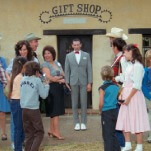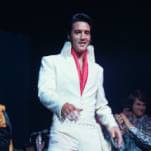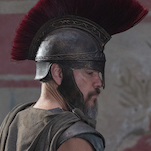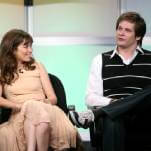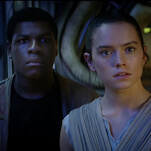AVC: Your movies often require actors to use bizarre props or perform alongside elaborate special effects. How do you build trust with actors and convince them that they’re not going to look silly—or that they’ll look silly in the right way?
MG: I think they know my other movies, and so they come in feeling—or I hope they feel this way—that they’re in good hands. We talk. I show them drawings. There is an amount of abstraction in my movies, and sometimes they don’t really understand it until the film is finished, and they’ll say, “Ah, that’s what you meant. I wasn’t sure how it would look.” But most of the time, I think they trust me. And because I like to do things physically, they aren’t usually acting against a blue screen. The effects are in camera and on set. So they can see a little bit of what the work will look like. Sometimes, when people use too much blue screen in movies, the actors don’t look credible, because they have their own opinion of what the thing will look like, and each person has a different opinion.
AVC: There are definitely times when you can see actors struggling to respond to a green screen or to act against a character that isn’t actually there.
MG: Sometimes they don’t even feel like they’re in the same room. I read about some movie where they did everything on blue screen, and the actors were not even connecting to each other.
AVC: You’re a huge fan of practical effects. Do you ever envy filmmakers who just relegate all of their effects work to a digital team?
MG: Well, I did some blue screen work in Mood Indigo. But I want to use those machines to do something you can’t do practically. It’s been nearly 20 years, but when I did the video for the Rolling Stones [“Like A Rolling Stone”] I used digital technology, and I pushed it to the limit. So I’m not against the technology at all, I just don’t like to use it if it’s just to mimic what you can do with traditional methods.
AVC: You use both practical and digital effects for the biglemoi, that funny dance the characters do in Mood Indigo, in which their legs become freakishly elongated.
MG: The special effect was that they had a piece of material attached to their feet that was, like, two feet long. And at the end of this piece of material were shoes that were attached to fake legs made out of rubber that would reach to their hips. They were wearing blue stockings, so what we did in post-production was erase their real legs. But the fake legs are there. It was quite funny to see them moving around with them on.
AVC: Do you ever find it difficult to create an emotional reality when you’re surrounding your characters with these outlandish elements?
MG: It’s part of my job to maintain the emotional reality and the naturalism even when the atmosphere is contrived. But I find, surprisingly, that actors are liberated in their work if there’s stuff going on around them, because they can’t think too much about who they’re supposed to be. I like this kind of performance better than the kind delivered by actors who do technical exercises, who mimic or morph themselves into different characters. I’m not a huge fan of that type of acting. I like actors who just are who they are, with a little bit of qualification to adapt to their character. But mostly they just use their own personality to embody the character. In a way, putting them deep into this sort of complicated universe frees them from thinking about who they should be. They just are somebody.
AVC: You’re not a fan of the Method school of acting?
MG: No. I don’t like it. [Method actors] don’t really serve the movie, they use the movie to serve themselves. That’s my personal opinion. Most people feel otherwise. But I find it distracting. I like actors who don’t have to think too hard about what they have to do to achieve their performance.
AVC: So when casting, you just look for somebody that embodies the proper spirit?
MG: Well, it depends. When I cast Jim Carrey to play Joel in Eternal Sunshine, that was casting against type. But I feel there’s a quality in him that was perfect for the character. So it’s not something he’s going to reach by going outside of himself, it’s something that he’ll find he has in himself. You could argue that’s what Method acting is, but actors who are too attached to the Method feel they have to transform themselves in a way that’s too artificial or complicated. So when I did the movie with Jim Carrey, I had to find pieces of him that are like the character. I need those parts of the character to be in the actor already.
AVC: Film is a collaborative medium, but that seems especially true of your films. Your whole career, you’ve worked closely with musicians, actors, and writers with strong personalities.
MG: It’s how I’ve always worked. I started my own band [Oui Oui] in the ’80s. I met the leader of the band— Étienne [Charry], who actually did the score for Mood Indigo—in art school. He had a lot of visual ideas. When I’d do the videos for our band, I was the director because I had the camera, but Étienne and I came up with the ideas 50/50. Same thing when I work with Björk, she brings half of the ideas. The problem is when you get forced to use ideas that aren’t good. When I can filter the ideas and use the best of them, I am happy to collaborate. I did two movies with Charlie Kaufman, and we are able to really share the creativity on both. I really enjoyed that. Of course, from time to time, I want to do everything myself and be more involved on my own with the creative process. But I don’t mind the collaboration at all.
AVC: Do you think you’ll work with Charlie Kaufman again?
MG: Oh yes, sure. It’s more about him. He does a lot of work on his own now. But if he had a screenplay for me, or if I could come up with a concept that he’d agree to write, I would be super excited.
AVC: How much does Kaufman resemble the version of him Nicolas Cage plays in Adaptation?
MG: It’s… pretty close. It’s a little bit like Larry David in Curb Your Enthusiasm. Not that they’re the same person, but how [Kaufman] captures himself.
AVC: A few years ago, you did a fascinating film set almost entirely on a city bus called The We And The I. You workshopped the whole film with a group of kids from the Bronx, who basically play themselves. Did the young stars like the finished product?
MG: Yeah, they were really excited. We flew nine of them to Cannes when it screened there, and none of them had been to Europe, so they were so excited. Something that’s a little sad is that for most of them, it was a one-time experience. That’s one of the reasons I wish the movie had more box-office recognition. Because then some of them could do that again. They had a great experience, but some of the realities are hard. I was very careful to explain that you don’t just immediately go to Hollywood and have a career—it doesn’t work that way. It’s a very closed world. But I think they were very mature about that and they just took it as a great experience. Of course they love the movie. And I’m very proud of that movie. It was done under very specific conditions. It was an experiment and we did this two-year workshop. Everybody who was involved in the workshop ended up on the bus, so there was no casting process. It was just them being themselves. I had a great time doing it.



































